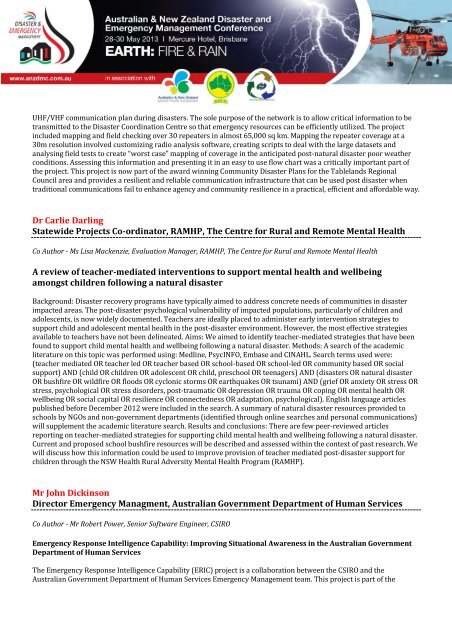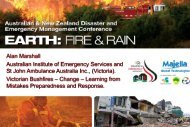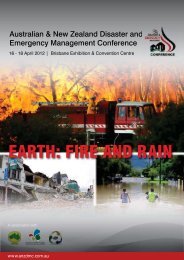Book of Abstracts 2013 - Australian and New Zealand Disaster ...
Book of Abstracts 2013 - Australian and New Zealand Disaster ...
Book of Abstracts 2013 - Australian and New Zealand Disaster ...
Create successful ePaper yourself
Turn your PDF publications into a flip-book with our unique Google optimized e-Paper software.
UHF/VHF communication plan during disasters. The sole purpose <strong>of</strong> the network is to allow critical information to be<br />
transmitted to the <strong>Disaster</strong> Coordination Centre so that emergency resources can be efficiently utilized. The project<br />
included mapping <strong>and</strong> field checking over 30 repeaters in almost 65,000 sq km. Mapping the repeater coverage at a<br />
30m resolution involved customizing radio analysis s<strong>of</strong>tware, creating scripts to deal with the large datasets <strong>and</strong><br />
analysing field tests to create “worst case” mapping <strong>of</strong> coverage in the anticipated post-natural disaster poor weather<br />
conditions. Assessing this information <strong>and</strong> presenting it in an easy to use flow chart was a critically important part <strong>of</strong><br />
the project. This project is now part <strong>of</strong> the award winning Community <strong>Disaster</strong> Plans for the Tablel<strong>and</strong>s Regional<br />
Council area <strong>and</strong> provides a resilient <strong>and</strong> reliable communication infrastructure that can be used post disaster when<br />
traditional communications fail to enhance agency <strong>and</strong> community resilience in a practical, efficient <strong>and</strong> affordable way.<br />
Dr Carlie Darling<br />
Statewide Projects Co-ordinator, RAMHP, The Centre for Rural <strong>and</strong> Remote Mental Health<br />
Co Author - Ms Lisa Mackenzie, Evaluation Manager, RAMHP, The Centre for Rural <strong>and</strong> Remote Mental Health<br />
A review <strong>of</strong> teacher-mediated interventions to support mental health <strong>and</strong> wellbeing<br />
amongst children following a natural disaster<br />
Background: <strong>Disaster</strong> recovery programs have typically aimed to address concrete needs <strong>of</strong> communities in disaster<br />
impacted areas. The post-disaster psychological vulnerability <strong>of</strong> impacted populations, particularly <strong>of</strong> children <strong>and</strong><br />
adolescents, is now widely documented. Teachers are ideally placed to administer early intervention strategies to<br />
support child <strong>and</strong> adolescent mental health in the post-disaster environment. However, the most effective strategies<br />
available to teachers have not been delineated. Aims: We aimed to identify teacher-mediated strategies that have been<br />
found to support child mental health <strong>and</strong> wellbeing following a natural disaster. Methods: A search <strong>of</strong> the academic<br />
literature on this topic was performed using: Medline, PsycINFO, Embase <strong>and</strong> CINAHL. Search terms used were:<br />
(teacher mediated OR teacher led OR teacher based OR school-based OR school-led OR community based OR social<br />
support) AND (child OR children OR adolescent OR child, preschool OR teenagers) AND (disasters OR natural disaster<br />
OR bushfire OR wildfire OR floods OR cyclonic storms OR earthquakes OR tsunami) AND (grief OR anxiety OR stress OR<br />
stress, psychological OR stress disorders, post-traumatic OR depression OR trauma OR coping OR mental health OR<br />
wellbeing OR social capital OR resilience OR connectedness OR adaptation, psychological). English language articles<br />
published before December 2012 were included in the search. A summary <strong>of</strong> natural disaster resources provided to<br />
schools by NGOs <strong>and</strong> non-government departments (identified through online searches <strong>and</strong> personal communications)<br />
will supplement the academic literature search. Results <strong>and</strong> conclusions: There are few peer-reviewed articles<br />
reporting on teacher-mediated strategies for supporting child mental health <strong>and</strong> wellbeing following a natural disaster.<br />
Current <strong>and</strong> proposed school bushfire resources will be described <strong>and</strong> assessed within the context <strong>of</strong> past research. We<br />
will discuss how this information could be used to improve provision <strong>of</strong> teacher mediated post-disaster support for<br />
children through the NSW Health Rural Adversity Mental Health Program (RAMHP).<br />
Mr John Dickinson<br />
Director Emergency Managment, <strong>Australian</strong> Government Department <strong>of</strong> Human Services<br />
Co Author - Mr Robert Power, Senior S<strong>of</strong>tware Engineer, CSIRO<br />
Emergency Response Intelligence Capability: Improving Situational Awareness in the <strong>Australian</strong> Government<br />
Department <strong>of</strong> Human Services<br />
The Emergency Response Intelligence Capability (ERIC) project is a collaboration between the CSIRO <strong>and</strong> the<br />
<strong>Australian</strong> Government Department <strong>of</strong> Human Services Emergency Management team. This project is part <strong>of</strong> the






